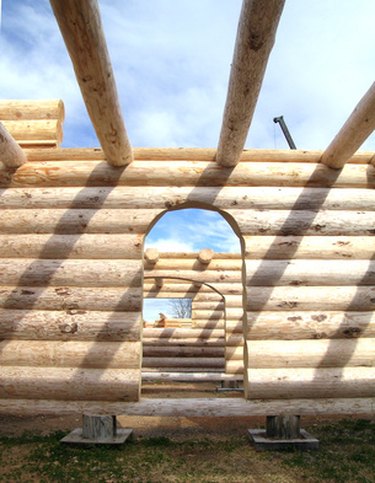
Carpenter bees live throughout the United States and, although there are different species, most resemble bumble bees. They are nuisances because they bore into wood to make a home. They will cause damage to any wood on your property, but a favorite target is your house. They make holes in eaves, wood overhangs and trim, fascia boards, decks, fence posts and trees. These holes are enlarged even more by woodpeckers seeking their favorite food — carpenter bee larvae. There are several stain additives that may temporarily deter carpenter bees. They are not fool-proof and, for the best results, they should be re-applied annually.
Carpenter Bee Habits
Video of the Day

Carpenter bees crawl between cracks in siding and roofing, where they bore holes about 1/2 inch wide and 1 or 2 inches long. This becomes a chamber where the female lays eggs, leaves a food ball of pollen and then seals the chamber. This system of chambers, containing eggs, may extend 2 or more feet through the wood, parallel to the grain. The larvae hatch in late summer and the adults spend the cold months in their nest tunnels. In spring, they emerge, mate and begin burrowing and laying more eggs.
Video of the Day
Paint or Siding
Carpenter bees love soft woods like pine, cedar, redwood and Douglas fir. Treated lumber is less attractive, and they don't like painted wood. Polyurethane paints are the best defense; a house should be painted regularly because exposed wood can bring on a full bee attack. Some homeowners, worn out by stubborn carpenter bees, opt for aluminum, vinyl, asphalt or non-wood siding to get rid of the pests.
NBS-30 Stain and Paint Additive
NBS-30 repels and deters bees from wood surfaces for about two years. It's added to paint and stain and inhibits insects when mixed with water and sprayed on for temporary control. Repeat in 30 to 60 days. It can be mixed with commercial oil or water-based exterior paints. This citronella-based product should be re-applied to a log home every time it is stained, and should always be in the final application. Use 1 pint per 5-gallon pail of log finish. NBS-30 works best with oil-based log products, and can cause surface irregularities in combination with water-based, clear log stains.
Bug Juice
Bug Juice is a paint additive designed to kill most flying and crawling insects that alight on treated surfaces. It's a deltamethryn-based insecticide that mixes well with water-based stains. When carpenter bees walk on treated surfaces, the chemical gets on their legs and kills them within one to three hours. If the home becomes covered with dust, dirt, or pollen, the insecticide is ineffective because bees must be in direct contact with the chemicals.
BeeGone and Outlast Q8 Log Oil
BeeGone, a contact insecticide, is effective as a sprayed-on spot treatment of carpenter bees. This pyrethrum-based insecticide should be applied wherever there's carpenter bee activity. It kills bees on the spot and should be repeated monthly during bee season. Outlast Q8 Log Oil, an exterior, oil log preservative, deters mold, termites and powder post beetles, and inhibits nesting insects. It contains Copper 8, toxic to wood-eating insects, but doesn't have much effect on carpenter bees that bore through wood rather than eating it.
- Alabama Cooperative Extension: Carpenter Bees-Biology and Management
- Log Finish: Log Finish Carpenter Bee Solutions, Bee Gone,NBS 30, Bug Juice
- Carpenter Bees: Carpenter Bee Control
- Bugspray: NBS Paint Additive
- Mountain Home Building Products: Carpenter Bee Repellant,NBS-30 Bug Repellant
- Connecticutt Government: Connecticutt Agricultural Experiment Station: Carpenter Bees
- The Bug Clinic: Carpenter Bees and Their Control